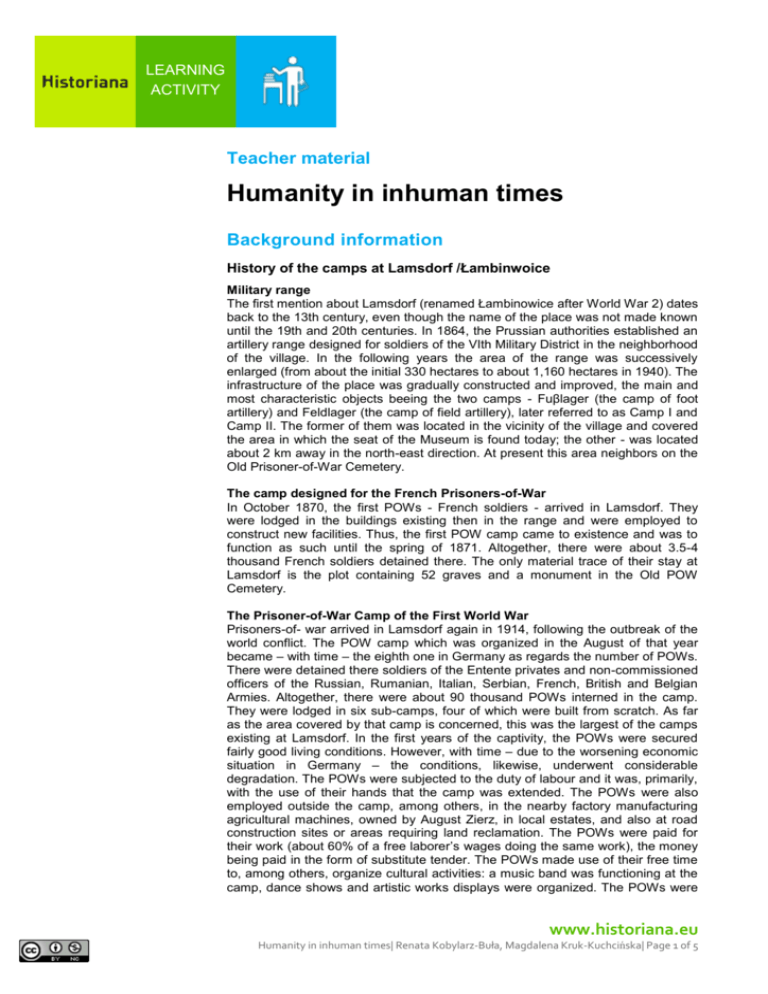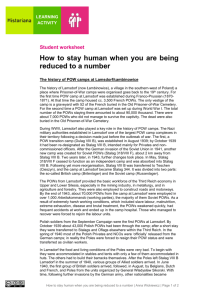Background Information
advertisement

LEARNING ACTIVITY Teacher material Humanity in inhuman times Background information History of the camps at Lamsdorf /Łambinwoice Military range The first mention about Lamsdorf (renamed Łambinowice after World War 2) dates back to the 13th century, even though the name of the place was not made known until the 19th and 20th centuries. In 1864, the Prussian authorities established an artillery range designed for soldiers of the VIth Military District in the neighborhood of the village. In the following years the area of the range was successively enlarged (from about the initial 330 hectares to about 1,160 hectares in 1940). The infrastructure of the place was gradually constructed and improved, the main and most characteristic objects beeing the two camps - Fuβlager (the camp of foot artillery) and Feldlager (the camp of field artillery), later referred to as Camp I and Camp II. The former of them was located in the vicinity of the village and covered the area in which the seat of the Museum is found today; the other - was located about 2 km away in the north-east direction. At present this area neighbors on the Old Prisoner-of-War Cemetery. The camp designed for the French Prisoners-of-War In October 1870, the first POWs - French soldiers - arrived in Lamsdorf. They were lodged in the buildings existing then in the range and were employed to construct new facilities. Thus, the first POW camp came to existence and was to function as such until the spring of 1871. Altogether, there were about 3.5-4 thousand French soldiers detained there. The only material trace of their stay at Lamsdorf is the plot containing 52 graves and a monument in the Old POW Cemetery. The Prisoner-of-War Camp of the First World War Prisoners-of- war arrived in Lamsdorf again in 1914, following the outbreak of the world conflict. The POW camp which was organized in the August of that year became – with time – the eighth one in Germany as regards the number of POWs. There were detained there soldiers of the Entente privates and non-commissioned officers of the Russian, Rumanian, Italian, Serbian, French, British and Belgian Armies. Altogether, there were about 90 thousand POWs interned in the camp. They were lodged in six sub-camps, four of which were built from scratch. As far as the area covered by that camp is concerned, this was the largest of the camps existing at Lamsdorf. In the first years of the captivity, the POWs were secured fairly good living conditions. However, with time – due to the worsening economic situation in Germany – the conditions, likewise, underwent considerable degradation. The POWs were subjected to the duty of labour and it was, primarily, with the use of their hands that the camp was extended. The POWs were also employed outside the camp, among others, in the nearby factory manufacturing agricultural machines, owned by August Zierz, in local estates, and also at road construction sites or areas requiring land reclamation. The POWs were paid for their work (about 60% of a free laborer’s wages doing the same work), the money being paid in the form of substitute tender. The POWs made use of their free time to, among others, organize cultural activities: a music band was functioning at the camp, dance shows and artistic works displays were organized. The POWs were www.historiana.eu Humanity in inhuman times| Renata Kobylarz-Buła, Magdalena Kruk-Kuchcińska| Page 1 of 5 LEARNING ACTIVITY allowed to perform their religious practices without any major obstacle (the services were carried out by priests of several denominations). There were around 7 thousand prisoners-of- war who did not manage to survive the captivity. They were buried in separate graves in the Old POW Cemetery nearby the graves of the French soldiers of 1871. The last POWs left Lamsdorf in 1920, that is about 2 years after the conclusion of the military actions. The repatriates camp 1921-1924 After the War, according to the resolutions of the Treaty of Versaille, the major part of the camp infrastructure was dismantled. The sub-camps III, IV and VI were liquidated completely. In the others, in 1921, German immigrants who came from the territories which were annexed to the Republic of Poland after the War and following the Silesian Uprisings, were lodged. The camp established at that time existed until 1924, accommodating several thousand people on the whole. World War 2 Six days prior to the outbreak of World War 2, on 26 August 1939, there was taken the decision of establishing a transition camp – a dulag – designed for prisonersof- war of the campaign in Poland in the area of the artillery range at Lamsdorf. In October, the dulag was transformed into a permanent camp for privates and NCOs – Stalag VIII B Lamsdorf. Up till December 1943 the camp functioned under this name. In July 1941,2 km away in the north-west direction, there was set up a new camp – Stalag 318, shortly afterwards transformed into Stalag VIII F Lamsdorf, which was designed for soldiers of the Red Army. Stalags VIII B and 318/VIII F formed a camp complex of Lamsdorf, which underwent quite a number of organizational changes during the time of its existence. In the autumn of 1942, Stalag VIII B Lamsdorf was made to administratively control the distant Stalag VIII D Teschen (Cieszyn) and in the Summer of 1943 the same procedure was applied in the case of the other camp - Stalag 318/VIII F Lamsdorf. The complex of camps which was formed in this manner belonged to the largest in Europe. At the end of 1943 there followed yet another, as it turned out – the last organizational alteration: the camp at Teschen was isolated out of the complex and Stalag 344 was formed at Lamsdorf. It comprised the former Stalag VIII B Lamsdorf, also known as the British Camp due to the largest number of POWs of this nationality who were detained there, as well as Stalag 318/VIII F Lamsdorf, also referred to as the Soviet Camp. The POW camps at Lamsdorf accommodated soldiers of ten regular armies fighting against the military forces of the Third Reich. Among them there were POWs of at least 49 nationalities, representing all the inhabited continents. The most numerous group were the Soviet POWs (about 180–200 thousand), the Polish POWs (c. 72 thousand) and the British POWs (c. 48 thousand). Apart from those there were also soldiers of the French, Belgian, Yugoslavian, Greek, American, and Italian Armies; towards the end of the War also those of the Rumanian Army. Another group worth paying attention to were POWs-participants in national uprisings, who arrived in Lamsdorf in the Autumn of 1944. The first, arriving on 5 and 7 October, were Warsaw insurgents. Altogether there were about 6 thousand of them, including about 1,000 women and 600 children. In the same month the first Slovakian insurgents were brought to the camp (all in all, there were about 1.6 thousand of them in the camp). The multinational complex of POW camps at Lamsdorf was the arena of particularly clearly visible differences as regards treatment of POWs of individual armies and nationalities. It was a characteristic feature typical of the German POW system. Relatively the best conditions of the captivity were offered to soldiers of the British Army, whereas the www.historiana.eu Humanity in inhuman times| Renata Kobylarz-Buła, Magdalena Kruk-Kuchcińska| Page 2 of 5 LEARNING ACTIVITY worst – to soldiers of the Red Army. For the latter the camps were the place of extermination. All the POWs were obliged to work, being employed, chiefly, in the industry, agriculture, forestry of Upper Silesia, as well as in many branches of the German economy. Labor gangs were formed and usually sent away to carry out hard, dangerous, exhaustive and lowly-paid jobs. The prisoners-of-war opposed their being absolutely subordinated to the brutal camp reality, including the extremely harsh living conditions and the enforcement to work in the captivity, by keeping up their strong will to survive, which contained a grain of normality. It was secured by their undertaking cultural, educational and sports activities. The inner force was also very often strengthened by the faith in God. The living conditions in Stalag VIII B Lamsdorf were hard and similar to those encountered in the other POW camps of the Third Reich. So was the camp regime. The POWs were obligatorily employed in agriculture, forestry and industry. Their cultural-educational, religious and sports activities helped the POWs survive the captivity; likewise were the correspondence and pack-ages received from the nearest and charities of invaluable support at the hard time of internment. The history of the camps saw a few especially tragic periods, among which the beginning of the functioning of Stalag 318/VIII F was of particular importance. The Soviet POWs, who were kept there, due to the lack of huts for living, in their majority were left to live in the open air. They were forced to survive the winter season in dugouts made by hand. When, in November, epidemic of typhus broke out, the camp was declared a quarantine area and the POWs remaining within it were left to themselves. According to estimates between 3 and 6 thousand POWs died during that time. The living conditions in Stalag VIII F were much harder than those in the neighboring "British camp". The POWs detained here had to fight against hunger, cold, illnesses; they had to live over extremely crowded space, work hard, beyond their capacity, and suffer an exceptionally bad treatment from the camp authorities. Their cultural and educational activity and religious practices (performed by the Soviet POWs on a very limited scale, though) offered the only relief and helped survive the harsh reality. The evacuation of the camp begun on 20 January, 1945, was of similarly tragic character: the majority of POWs were forced to march in the conditions of exceptionally severe winter, without suitable food or rest. There were about 3 thousand POWs who were left behind at the camp because of being sick or unable to walk, which equaled being sentenced to slow death. Only about 500 of them were strong enough to see the liberation of the camp on 17–18 March, 1945. During World War 2 there were altogether over 300 thousand POWs detained at the camps of Lamsdorf. About 40 thousand of them did not manage to survive their stay in that place, the largest toll being among the soldiers of the Red Army. After World War 2 In the July of 1945, in the vicinity of the former Stalag 318/VIII F Lamsdorf, the main burial place of the Soviet POWs was discovered. On the turn of 1945 and 1946 there were Polish and Soviet medical-forensic commissions working on the spot at Łambinowice, whose task was to investigate the crime perpetrated on the www.historiana.eu Humanity in inhuman times| Renata Kobylarz-Buła, Magdalena Kruk-Kuchcińska| Page 3 of 5 LEARNING ACTIVITY POWs. Witnesses were interviewed and survey exhumations were carried out. The latter were executed, among others, with the help of the detained at the Labour Camp in Łambinowice, who were employed for the purpose. In November 1945 and January 1946 formal funerals took place. The Labor Camp at Łambinowice It was one of many camps designed for the Germans waiting to be displaced to the heart of Germany (according to the decisions taken by the superpowers in Potsdam) that were organized in Silesia by the Polish administration. The camp was located in the area of the so-called Camp I, in its northernmost part, which was formed the latest, that is towards the end of the 1930s. During the Second World War no Prisoners-of-War were detained here. The camp functioned from July 1945 till October 1946 as one designed for displaced people. It also played the role of a labor camp, isolation and repression center. Altogether there were about 5 thousand men, women, children and elderly people detained here. They came from about 150 places, yet the most numerous group were inhabitants of 30 nearby villages, including Poles. Among the detained there were members of Nazi organizations and guards of the POW camps at Lamsdorf. The hard living conditions they encountered, hunger, illnesses (an epidemic of typhus), as well as maltreatment they suffered from the Polish camp authorities caused them to die in large numbers. The deceased were buried in anonymous single or mass graves at the rear of the camp or outside of it. The Site of National Remembrance at Łambinowice The process of commemorating the tragic history of this place was basically commenced in the 60s of the former century. In 1964, the Cemetery of the Soviet Prisoners-of-War was officially opened and the Monument of Martyrdom of Prisoners-of-War was unveiled. The Museum was also established in that year. In 1968, the area of the former POW camps and the Cemetery was declared the Site of National Remembrance. In 2002, the Site was extended by including the area of the former Labour Camp in Łambinowice (1945–1946). The whole area was named the Site of National Remembrance in Łambinowice. Background information: About the newsreel The newsreel which presents works undertaken during digging up the mass graves of Soviet prisoners of war in Łambinowice was most likely filmed in the second half of 1945 (August or September) on the territory of massive graves of Soviet prisoners of war in Łambinowice. They were accidentally discovered in July 1945 within about 2,5km from a village Łambinowice, near Klucznik village (today it does not exist), about 0,5km from the former Stalag 318/VIIIF (344) Lamsdorf camp. The camp was functioning until 17th March 1945, when the Red Army encroached on the territory of the camp and released few prisoners of war who were still alive. The massive graves were discovered in summer 1945 and as a result Polish and Soviet commissions investigating the crime appeared in Łambinowice. In autumn 1945 the works were more organized. Even today the commission’s results are reliable source of information about the number of victims of Lamsdorf camps at the time of the World War II: it is about 40 thousand prisoners of war (mostly Soviet prisoners of war, the rest included Britishmen, Americans, Poles and other prisoners – among them there were not more than one thousand victims). They were buried twice: on 2nd November 1945 and 26th January. When the works were completed, the material was given to Polska Kronika Fimowa (Polish Film Newsreel) by citizens of the USSR, who were the authors of the material. www.historiana.eu Humanity in inhuman times| Renata Kobylarz-Buła, Magdalena Kruk-Kuchcińska| Page 4 of 5 LEARNING ACTIVITY This unquestionable interesting material was provided with verbal message and as a result, it is not only a film document, but also a documental film. What should have remembered the viewers, what was the form of the film for? It can be indicated that history presented in the film was supposed to be both an argument and a tool of legitimization. The shots from massive graves together with a commentary about the number of victims and their origin (which is characterized with drama in the verbal part, for example “the message electricized” or “the most scary shooting range of the world”) lead to a following conclusion: “The discovery of new German crime appears timely as an answer for those, who like people who haven’t been taught, anew agitate for great understanding, they demand accepting German murderers to the community of free nations of the world.” In this perspective history is an argument: at that time, not distant past of the war was used by post-war Polish authorities to blame both western Germany and policy of Anglo-Saxon countries (which were not directly named), which pursued their own policy towards Germans in subordinated areas occupied by them because of the fear of growing conflict with the USSR and clear division of Europe. At the other side there was the USSR and countries under its influence – the Soviet soldiers represented in the film, recalling the memory of victims and putting forward the request to punish the perpetrators, is the element legitimizing the policy of the USSR and communism in general. What was not the purpose of the material? The manipulation in the film does not allow to state that it was good for doing justice for the victims and their memory. They were only pretext to express political beliefs. To a limited extent the document was to popularize knowledge about such place like Łambinowice. It contains selective and mistaken information. They chose a fragment of the history of this place and showed it in a generalised and selective way (while at the time of the World War II in Lamsdorf camp there were soldiers from 10 world armies, more than 50 countries). It contains completely mistaken information: 100 thousand victims. The false or uncompleted information mixes with true information, for example the reader in the film says that the local community could not come close to the internment camps and burial places. During watching the film we cannot find out what was the nationality of the people. What is more, it is worth to pay attention to iconography of the film material. It gives us one hidden information which is not explained in a commentary. It was a problem of people working at exhumation including women. There is no explanation that they were German women working in a nearby labour camp in Łambinowice, which started working in June 1945 and finished in October 1946. The camera operator wanted to show the cross as a symbol of tribute to Soviet prisoners of war, but while taking into consideration the women working at exhumation works, it is a mockery of human pain. Summing up, the scope of manipulation in the video material has a considerable impact on the viewer. www.historiana.eu Humanity in inhuman times| Renata Kobylarz-Buła, Magdalena Kruk-Kuchcińska| Page 5 of 5







